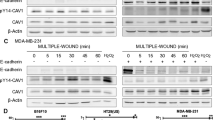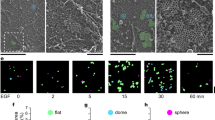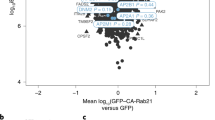Abstract
Growth of normal cells is anchorage dependent because signalling through multiple pathways including Erk, phosphatidylinositol-3-OH kinase (PI(3)K) and Rac requires integrin-mediated cell adhesion1. Components of these pathways localize to low-density, cholesterol-rich domains in the plasma membrane named 'lipid rafts'2,3 or 'cholesterol-enriched membrane microdomains' (CEMM)4. We previously reported that integrin-mediated adhesion regulates CEMM transport such that cell detachment from the extracellular matrix triggers CEMM internalization and clearance from the plasma membrane5. We now report that this internalization is mediated by dynamin-2 and caveolin-1. Internalization requires phosphorylation of caveolin-1 on Tyr 14. A shift in localization of phospho-caveolin-1 from focal adhesions to caveolae induces CEMM internalization upon cell detachment, which mediates inhibition of Erk, PI(3)K and Rac. These data define a novel molecular mechanism for growth and tumour suppression by caveolin-1.
This is a preview of subscription content, access via your institution
Access options
Subscribe to this journal
Receive 12 print issues and online access
$209.00 per year
only $17.42 per issue
Buy this article
- Purchase on Springer Link
- Instant access to full article PDF
Prices may be subject to local taxes which are calculated during checkout




Similar content being viewed by others
Accession codes
References
Schwartz, M. A. Integrins, oncogenes, and anchorage independence. J. Cell Biol. 139, 575–578 (1997).
Edidin, M. The state of lipid rafts: from model membranes to cells. Annu. Rev. Biophys. Biomol. Struct. 32, 257–283 (2003).
Lagerholm, B. C., Weinreb, G. E., Jacobson, K. & Thompson, N. L. Detecting microdomains in intact cell membranes. Annu. Rev. Phys. Chem. 56, 309–336 (2005).
Grande, A., Echarri, A. & del Pozo, M. A. Integrin regulation of membrane domain trafficking and Rac targeting. Biochem. Soc. Trans. 33, 609–613 (2005).
del Pozo, M. A. et al. Integrins regulate Rac targeting by internalization of membrane domains. Science 303, 839–842 (2004).
del Pozo, M. A., Price, L. S., Alderson, N. B., Ren, X. D. & Schwartz, M. A. Adhesion to the extracellular matrix regulates the coupling of the small GTPase Rac to its effector PAK. EMBO J. 19, 2008–2014 (2000).
Parton, R. G. Caveolae — from ultrastructure to molecular mechanisms. Nat. Rev. Mol. Cell Biol. 4, 162–167 (2003).
Pelkmans, L., Puntener, D. & Helenius, A. Local actin polymerization and dynamin recruitment in SV40-induced internalization of caveolae. Science 296, 535–539 (2002).
Fielding, C. J. & Fielding, P. E. Caveolae and intracellular trafficking of cholesterol. Adv. Drug Deliv. Rev. 49, 251–264 (2001).
Cao, H., Courchesne, W. E. & Mastick, C. C. A phosphotyrosine-dependent protein interaction screen reveals a role for phosphorylation of caveolin-1 on tyrosine 14: recruitment of C-terminal Src kinase. J. Biol. Chem. 277, 8771–8774 (2002).
Lee, H. et al. Constitutive and growth factor-regulated phosphorylation of caveolin-1 occurs at the same site (Tyr-14) in vivo: identification of a c-Src/Cav-1/Grb7 signaling cassette. Mol. Endocrinol. 14, 1750–1775 (2000).
Engelman, J. A. et al. Recombinant expression of caveolin-1 in oncogenically transformed cells abrogates anchorage-independent growth. J. Biol. Chem. 272, 16374–16381 (1997).
Fiucci, G., Ravid, D., Reich, R. & Liscovitch, M. Caveolin-1 inhibits anchorage-independent growth, anoikis and invasiveness in MCF-7 human breast cancer cells. Oncogene 21, 2365–2375 (2002).
Wiechen, K. et al. Caveolin-1 is down-regulated in human ovarian carcinoma and acts as a candidate tumor suppressor gene. Am. J. Pathol. 159, 1635–1643 (2001).
Capozza, F. et al. Absence of caveolin-1 sensitizes mouse skin to carcinogen-induced epidermal hyperplasia and tumor formation. Am. J. Pathol. 162, 2029–2039 (2003).
Williams, T. M. et al. Caveolin-1 gene disruption promotes mammary tumorigenesis and dramatically enhances lung metastasis in vivo. Role of Cav-1 in cell invasiveness and matrix metalloproteinase (MMP-2/9) secretion. J. Biol. Chem. 279, 51630–51646 (2004).
Lee, H. et al. Caveolin-1 mutations (P132L and null) and the pathogenesis of breast cancer: caveolin-1 (P132L) behaves in a dominant-negative manner and caveolin-1 (−/−) null mice show mammary epithelial cell hyperplasia. Am. J. Pathol. 161, 1357–1369 (2002).
Murata, M. et al. VIP21/caveolin is a cholesterol-binding protein. Proc. Natl Acad. Sci. USA 92, 10339–10343 (1995).
Sabharanjak, S., Sharma, P., Parton, R. G. & Mayor, S. GPI-anchored proteins are delivered to recycling endosomes via a distinct cdc42-regulated, clathrin-independent pinocytic pathway. Dev. Cell 2, 411–423 (2002).
Damm, E. M. et al. Clathrin- and caveolin-1-independent endocytosis: entry of simian virus 40 into cells devoid of caveolae. J. Cell Biol. 168, 477–488 (2005).
Razani, B. et al. Caveolin-1 null mice are viable but show evidence of hyperproliferative and vascular abnormalities. J. Biol. Chem. 276, 38121–38138 (2001).
Mettouchi, A. et al. Integrin-specific activation of Rac controls progression through the G(1) phase of the cell cycle. Mol. Cell 8, 115–127 (2001).
Boyd, N. D., Chan, B. M. & Petersen, N. O. β1 integrins are distributed in adhesion structures with fibronectin and caveolin and in coated pits. Biochem. Cell Biol. 81, 335–348 (2003).
Parton, R. G., Joggerst, B. & Simons, K. Regulated internalization of caveolae. J. Cell Biol. 127, 1199–1215 (1994).
Aoki, T., Nomura, R. & Fujimoto, T. Tyrosine phosphorylation of caveolin-1 in the endothelium. Exp. Cell Res. 253, 629–636 (1999).
Wary, K. K., Mariotti, A., Zurzolo, C. & Giancotti, F. G. A requirement for caveolin-1 and associated kinase Fyn in integrin signaling and anchorage-dependent cell growth. Cell 94, 625–634 (1998).
Palazzo, A. F., Eng, C. H., Schlaepfer, D. D., Marcantonio, E. E. & Gundersen, G. G. Localized stabilization of microtubules by integrin- and FAK-facilitated Rho signaling. Science 303, 836–839 (2004).
Drab, M. et al. Loss of caveolae, vascular dysfunction, and pulmonary defects in caveolin-1 gene-disrupted mice. Science 293, 2449–2452 (2001).
Sunaga, N. et al. Different roles for caveolin-1 in the development of non-small cell lung cancer versus small cell lung cancer. Cancer Res. 64, 4277–4285 (2004).
Machleidt, T., Li, W. P., Liu, P. & Anderson, R. G. Multiple domains in caveolin-1 control its intracellular traffic. J. Cell Biol. 148, 17–28 (2000).
Acknowledgements
We thank M. P. Lisanti for the caveolin-1-null MEFs, C. C. Mastick for the caveolinY14F vector, S. Schmid for the dynamin constructs, D. Castle for the Eps15DIII mutant and H68.4 monoclonal antibody, N. Meller for the Cdc42 inhibitor CBD-WASP, W.-P. Li, Y. Ying and J. Redick for assistance in electron microscopy analysis, M. C. Montoya and D. Megías for assistance with the Leica ultra-spectral confocal microscope, E. M. Moreno for technical assistance, and S. Schmid, M. Ginsberg, S. Shattil and K. Ley for critical reading of the manuscript. This work was supported by MEC (Spanish Ministry of Science and Education) through grants SAF2002-0245 and GEN2003-20239-C06-04 to M.A.d.P., a predoctoral fellowship (BEF-2003-2712, to A.G.-G.), and the Ramón y Cajal Program (to M.A.d.P.); and by EUROHORCS (European Heads Of Research Councils) and European Science Foundation (ESF) through a EURYI (European Young Investigator) Award to M.A.d.P.; USPHS grant RO1 GM47214 to M.A.S.; and grants from NIH and the Perot Family Foundation to R.G.W.A. A significant part of this work was performed while some of the authors were located in the Departments of Immunology (M.A.d.P. and N.B.A., from January 2003 to June 2004) and Cell Biology (M.A.d.P., N.B.A. and W.B.K. until June 2004, and M.A.S. until July 2002) at The Scripps Research Institute, CA.
Author information
Authors and Affiliations
Corresponding author
Ethics declarations
Competing interests
The authors declare no competing financial interests.
Supplementary information
Supplementary Information
Supplementary figures S1, S2, S3 and S4 (PDF 470 kb)
Rights and permissions
About this article
Cite this article
del Pozo, M., Balasubramanian, N., Alderson, N. et al. Phospho-caveolin-1 mediates integrin-regulated membrane domain internalization. Nat Cell Biol 7, 901–908 (2005). https://doi.org/10.1038/ncb1293
Received:
Accepted:
Published:
Issue Date:
DOI: https://doi.org/10.1038/ncb1293
This article is cited by
-
Optimizing irradiation conditions for low-intensity pulsed ultrasound to upregulate endothelial nitric oxide synthase
Journal of Medical Ultrasonics (2024)
-
Endothelial cell CD36 regulates membrane ceramide formation, exosome fatty acid transfer and circulating fatty acid levels
Nature Communications (2023)
-
Optineurin links Hace1-dependent Rac ubiquitylation to integrin-mediated mechanotransduction to control bacterial invasion and cell division
Nature Communications (2022)
-
Endocytosis in the context-dependent regulation of individual and collective cell properties
Nature Reviews Molecular Cell Biology (2021)
-
The non-receptor tyrosine phosphatase type 14 blocks caveolin-1-enhanced cancer cell metastasis
Oncogene (2020)



